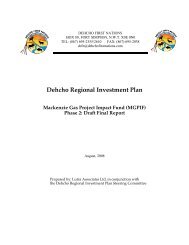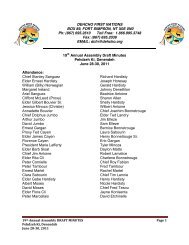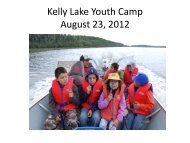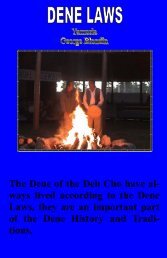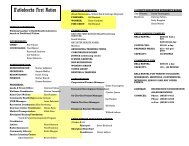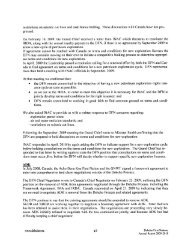NWT 2011-2015 - NWT Species at Risk
NWT 2011-2015 - NWT Species at Risk
NWT 2011-2015 - NWT Species at Risk
You also want an ePaper? Increase the reach of your titles
YUMPU automatically turns print PDFs into web optimized ePapers that Google loves.
1. Background – Why rank the general st<strong>at</strong>us of all wild species?<br />
The Northwest Territories is home to <strong>at</strong> least 30,000<br />
species. Some of these have a very important place<br />
in our economy and our cultures. Some species are facing<br />
thre<strong>at</strong>s due to human activities and other species are simply<br />
very rare. During the past few decades, we have recognized<br />
the need to broaden our monitoring efforts. The loss of a<br />
single species may have neg<strong>at</strong>ive consequences th<strong>at</strong> ripple<br />
through an ecosystem, resulting in thre<strong>at</strong>s to the survival of<br />
both game and non-game species. Increasing our knowledge<br />
of all species is essential to modern wildlife management<br />
and ecologically sustainable development. We now can<br />
provide baseline inform<strong>at</strong>ion on a gre<strong>at</strong>er number of animals<br />
and plants, and can report on how each species is doing in<br />
general. <strong>Species</strong> th<strong>at</strong> are found to need special <strong>at</strong>tention are<br />
noted and prioritized for further assessment.<br />
Our Commitments under the Accord<br />
for the Protection of <strong>Species</strong> <strong>at</strong> <strong>Risk</strong><br />
in Canada<br />
The Government of the Northwest Territories signed<br />
the Accord for the Protection of <strong>Species</strong> <strong>at</strong> <strong>Risk</strong> in Canada.<br />
An important first step in providing effective protection to<br />
species is to prevent them from ever becoming <strong>at</strong> risk.<br />
This is done by monitoring, assessing and reporting<br />
regularly on the st<strong>at</strong>us of all wild species. Environment<br />
and N<strong>at</strong>ural Resources, working closely with the federal<br />
government, co-management boards, universities, research<br />
firms and knowledgeable people, has initi<strong>at</strong>ed the <strong>NWT</strong><br />
<strong>Species</strong> General St<strong>at</strong>us Ranking Program to fulfill its<br />
commitment to monitor the general st<strong>at</strong>us of wild species<br />
in the Northwest Territories. This document is the 3rd<br />
report of a continuing program.<br />
Our Particip<strong>at</strong>ion in the Assessment of<br />
<strong>Species</strong> <strong>at</strong> <strong>Risk</strong> in Canada<br />
The evalu<strong>at</strong>ion system described in this report uses<br />
a standard process th<strong>at</strong> is shared by all Canadian<br />
jurisdictions. This system is similar to systems used<br />
in other countries and by N<strong>at</strong>ureServe, the largest<br />
co-ordin<strong>at</strong>ed effort to rank the biological st<strong>at</strong>us of species<br />
in the western hemisphere. Link to www.n<strong>at</strong>ureserve.ca.<br />
As the Northwest Territories, and Nunavut, do not have yet<br />
a fully functioning N<strong>at</strong>ureServe program, the results of the<br />
General St<strong>at</strong>us Ranking Program can be used as a surrog<strong>at</strong>e.<br />
The results of the <strong>NWT</strong> <strong>Species</strong> General St<strong>at</strong>us Ranking<br />
Program are combined with the results of similar programs<br />
in each jurisdiction to develop an overall “Canada-wide<br />
rank” for each species. Canada-wide ranks for species in<br />
Canada can be found on the Wild <strong>Species</strong> – General St<strong>at</strong>us<br />
of <strong>Species</strong> in Canada web site. Link to www.wildspecies.ca.<br />
Canada-wide ranks are used to prioritize species in Canada<br />
for more detailed assessment by the Committee on the<br />
St<strong>at</strong>us of Endangered Wildlife in Canada (COSEWIC).<br />
Our New <strong>Species</strong> At <strong>Risk</strong> (<strong>NWT</strong>) Act<br />
In 2010, the Government of the Northwest Territories<br />
passed its first legisl<strong>at</strong>ion designed to protect species <strong>at</strong><br />
risk in the <strong>NWT</strong>, as part of a larger commitment to maintain<br />
the biodiversity of the <strong>NWT</strong>. The <strong>Species</strong> <strong>at</strong> <strong>Risk</strong> Committee<br />
(SARC), established under the <strong>Species</strong> At <strong>Risk</strong> (<strong>NWT</strong>) Act,<br />
assesses the biological st<strong>at</strong>us of species th<strong>at</strong> may be <strong>at</strong><br />
risk in the <strong>NWT</strong>. SARC uses the results of the <strong>NWT</strong> General<br />
St<strong>at</strong>us Ranking Program as a starting point to investig<strong>at</strong>e<br />
which species may have higher priority for a more detailed<br />
assessment. The detailed assessment is based on traditional,<br />
community and scientific knowledge of the biological st<strong>at</strong>us<br />
of the species.<br />
Our Particip<strong>at</strong>ion in Monitoring Biodiversity<br />
Across the Arctic<br />
This report helps The Arctic Council and its programs<br />
such as the Conserv<strong>at</strong>ion of Arctic Flora and Fauna (CAFF)<br />
monitor circumpolar biodiversity and to share inform<strong>at</strong>ion<br />
about Arctic species with other jurisdictions.<br />
Link to www.arctic-council.org and www.caff.is.<br />
2<br />
<strong>NWT</strong> <strong>Species</strong> <strong>2011</strong>-<strong>2015</strong>



